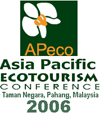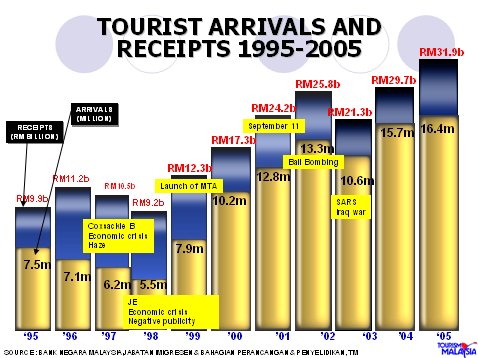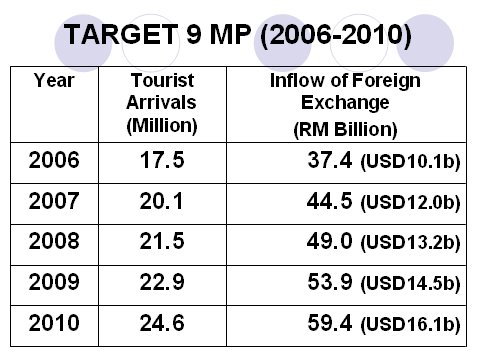|
ECOTOURISM OPPORTUNITIES IN THE ASIA PACIFIC
REGION: MALAYSIA
Dr. Junaida Lee Abdullah
Undersecretary
Policy, Planning and International Affairs Division
Ministry of Tourism Malaysia
3 November, 2006
Performance and Targets of Tourism Industry

Tourism Performance
In 2004
15.7 million foreign tourists
RM29.65 billion (USD7.8 billion)
Per capita Expenditure – RM1,888.2 (USD496.9)
Average length of stay – 6 nights
In 2005
16.4 million foreign tourists
RM31.9 billion (USD8.62 billion)
Per Capita Expenditure – RM2,134(USD561.6)
Average length of stay – 7.2 nights

ECOTOURISM DEVELOPMENT IN MALAYSIA
Malaysia is one of the World’s Twelve Mega Diversity Countries
Malaysia’s Marine & Coastal Habitats
Home to > 4,000 species of marine fishes; 4 species of marine
turtles nest on our beaches;
Habitats include mangrove forests, sea grass beds, coral reefs, mud
flats and sandy beaches
Malaysia’s Terrestrial Species
Mammals - 286 species, 27 endemic
Birds - 736 species, 9 endemic
Reptiles - 268 species, 68 endemic
Amphibians - 158 species, 57 endemic
Malaysia’s Freshwater Habitats
449 species of freshwater fishes;
Approximately 2 million hectares of peat swamp - home to the
Sumatran rhino, Storm’s stock and Proboscis monkey, among others
National Eco-Tourism Plan
A comprehensive plan adopted by the Government of Malaysia to assist
the Federal and State Governments in the development of the
eco-tourism potential.
It serves as an:
An appropriate instrument within the overall sustainable development
of Malaysia and the economy as a whole
an effective tool for the conservation of the natural and cultural
heritage of the country
Definition of Eco-Tourism
‘Environmentally responsible travel and visitation to relatively
undisturbed natural areas, in order to enjoy and appreciate nature
(and any accompanying cultural features, both past and present),
that promotes conservation, has low visitor impact, and provides for
beneficially active socio-economic involvement of local populations’
Implementing the Plan
The implementation of the Plan is set out in the 3 main interactive
co1313mponents:-
a) Action Plans ,
b) Site Proposals and;
c) Guidelines.
All three are equally important and each is meant to be implemented
with specific refence to the other two.
Site Listing
Identifies 10 very special places for ecotourism which have superb
natural assets and present opportunities for local participation
10 Very Special Places for Eco-tourism
Wang Kelian, Perlis – Limestone, caves & forest
Ulu Muda, Kedah – Forest, lake and sandstone
Belum/Temenggor, Perak – Wildlife, forest and lake
Pulau Kukup, Johor – Mangroves, wildlife, seafood
Tasik Bera, Pahang – Lake, culture, fish
10 Very Special Places for Eco-tourism (contd…)
Kenong Rimba Park, Pahang – Elephants, caves, streams
Kenyir Catchment, Terengganu – Lake, boating, trekking, fishing
Gunung Stong, Kelantan – Mountain, waterfall, rockfaces
Lower Kinabatangan River, Sabah – Probocis monkeys, river, wildlife
Hose Mountains, Sarawak – Forest, Trekking, Birdwatching
Ecotourism Development
Eight Malaysia Plan (2001-2005)
RM14.2 million (USD3.8 million) spent on 20 projects
Ninth Malaysia Plan (2006-2010)
Approved budget of RM260.6 million (USD70.4 million) for 73 projects
Ecotourism Projects Implemented Under Eighth Malaysian Plan
(2001-2005)
Wang Kelian Park, Perlis
Gua Kelam, Perlis
Gunong Jerai Park, Kedah
Belum Forest, Perak
Development of Nature Park, Kuala Selangor
Development of Firefly Centre, Selangor
Kuala Tahan, National Park, Pahang
Endau Rompin, Pahang
Taman Negara, Gunung Ledang, Muar, Johor
Ecotourism Projects Implemented Under Eighth Malaysian Plan
(2001-2005) …contd.
Development in Kukup, Johore
Pulau Besar & Pulau Sibu, Johore
Tasik Kenyir, Terengganu
Wildlife Sanctuary, Kinabatangan Sabah
Kinabalu Park, Sabah
Poring, Sabah
Mulu National Park, Sarawak
Niah Caves, Sarawak
PROMOTION OF
ECO-TOURISM PRODUCTS
Objectives
To increase awareness on eco-tourism products that has potential for
promotion in international market areas
To assist in developing eco-tourism packages jointly with tour
operators and other relevant agencies
To increase foreign tourist arrivals through the promotion of
eco-tourism products
Types of Eco-tourism Products
Rock climbing (Gua Musang, Kelantan)
Jungle Trekking (Mount Tahan, Mount Kinabalu)
White water rafting (Kiulu, Padas, Sabah)
Wildlife Sanctuary (Elephant Sanctuary Kuala Gandah)
National Park (Taman Negara)
Homestay and Agro-Tourism (Banghuris, Selangor & Pelegong in Negeri
Sembilan)
Developing Eco-tourism
in the IMT-GT and BIMP-EAGA regions
IMT-GT Area: Jewel of the Region
Sabong & Nias Islands, Levser National Park, Danau Lake Toba areas
in Sumatra
Langkawi Islands & various national parks, marine parks in Kedah,
Perlis, Perak and Gardens in Penang
The Southern Thailand area especially
Tarutas Marine Park & the Songkhla area
BIMP-EAGA Region: Heart of Borneo
Initiative to conserve 220,000 sq. km of rainforest in central
Borneo
A conservation zone linking protected areas and sustainably-managed
forests in Sabah, Sarawak, Brunei and Kalimantan
CHALLENGES AND CONCERNS
Challenges & Concerns
Conservation of environment and development of eco-tourism
Illegal logging
Low Product Knowledge
Still very low among local tour operators and tourist guides
Inadequate nature guides
Programme Sustainability
Issues of maintenance, efforts to update, redesigned & package it to
suit changing needs
Seasonal issues: Haze, Birdflu
Uncontrolled and excessive development resulting in overcrowding
Insufficient or inadequate tourism infrastructure & amenities
support resulting in pollution and degradation of ecotourism sites
Development of eco-tourism not properly planned according to the
carrying capacity of the site
The benefits of eco-tourism development not reaching the local
communities
Ecotourism sites poorly managed due to a lack of allocation for
maintenance, inadequate manpower as well as expertise in the
management of ecotourism products/activities
Approval of development projects by state governments and local
authorities often contradicts the principles of sustainable
development and do not considers ecotourism development as a viable
option & better alternative
Future Prospects
Outlook is very good
Vast potential of the ecotourism industry in the Asia Pacific region
To further enhance the growth of eco-tourism industry there should
be further collaborations between the private sectors and the public
sectors in their countries concerned.
Key factors
New product development
Enhance marketing strategy
Establish target markets & specialised market groups who are
interested in birding, caving, diving, plant enthusiasts,etc.
Publicity through print & electronic media including website
Provide accurate information provided by specialists
Organise familiarization tour for travel agents, media & specialised
group
Jointly participate in ecotourism travel fair in selected markets
|



